Jim Dine
'Mr. Oxide'
Signed Jim Dine and dated 2009 verso. Acrylic and sand on canvas 122 x 92 cm.
Provenance
Wetterling Gallery, Stockholm.
More information
Jim Dine's art has become strongly associated with his very personal circle of motifs. Recurring motifs include hearts, tools, brushes and Pinocchio. The painting, 'Mr. Oxide', features another of his most iconic motifs: the bathrobe. Executed in bright red, yellow, blue and green, the painting is a magnificent example of his expressive and colourful painting. Bathrobes have been a central motif throughout his career and recur in several of his many medias. Dine began depicting them in the 1960s, inspired by an advert in The New York Times in 1963. Although he himself has admitted that he never wore a bathrobe in person, they soon took the form of self-portraits. In an interview with ARTnews in September 1977, he described how he first became interested in the bathrobe as a subject: 'The ad shows a robe with the man airbrushed out of it. Well, it somehow looked like me, and I thought I'd make that a symbol for me. Actually, it all began when I wanted to paint a self-portrait . . . and just couldn't. It's important for me to say this, because what I really wanted to do was sit in front of a mirror and paint a portrait of myself. But at the time, I was in analysis and the pressures I felt prevented me from going through with it."
By allowing the robe to clothe an invisible body without head, legs and arms, he found the form perfectly suited to the rectangular composition he preferred to work with. The empty bathrobe becomes an inverted portrait of an unknown person, while retaining its painterly freedom of line and colour.
Dine began his career in the late 1950s as one of the youngest of the new generation of artists seeking a way forward from Abstract Expressionism. Jim Dine collaborated with the Pace Gallery in New York from 1978 to 2016, where he first exhibited his large paintings of bathrobe motifs. He has described his painting as a process of correction in which he repeatedly reworks a painting. Colour is added, removed and revised until the final result is achieved. Although he repeats his motifs, each work is unique, whether it is a collage, painting or drawing. His works explore the relationship between texture, colour and composition, allowing both himself and the viewer to apply their own feelings and ideas to the form.
Jim Dine has had more than 300 exhibitions during his career, including retrospectives at the Whitney Museum of American Art, New York (1970), the Museum of Modern Art, New York (1978), Museum Folkwang, Essen (2015-16), among others. He is a very popular artist and his work is in the collections of most of the world's major collectors and art institutions.


















































